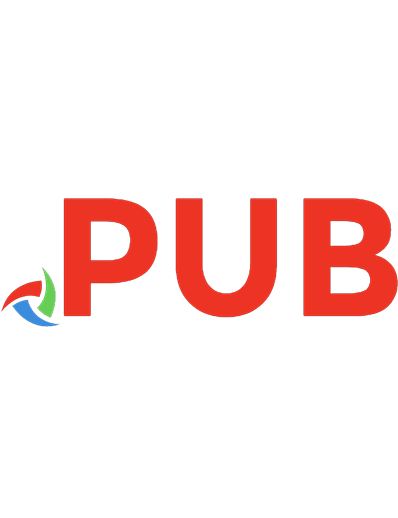Introduction To Cybersecurity: A Multidisciplinary Challenge [1 ed.] 3031414624, 9783031414626, 3031414632, 9783031414633, 9788750200239
This book provides an introduction to the basic ideas involved in cybersecurity, whose principal aim is protection of IT
347 106 9MB
English Pages xv, 440 [452] Year 2023
Table of contents :
Preface
Acknowledgments
Contents
Chapter 1 Introduction: Why Cybersecurity?
1.1 Information Security and Cybersecurity
1.1.1 The Development of the Internet
1.2 How Do Computers Work Together?
1.2.1 Systems of Systems
1.3 Cyberattacks Today
1.4 Security Targets
1.4.1 CIA Targets
1.4.2 Security Policies
1.5 Reader’s Guide
1.5.1 A Short Note on Notation
Chapter 2 Technique and Human Beings
2.1 Psychological Attacks
2.1.1 Curiosity
2.1.2 Helpfulness
2.1.3 Sympathy and Hate
2.1.4 Belief in Authority
2.1.5 The Brain’s Two Modes of Operation
2.1.6 Uncertainty in Decision Making
2.2 Phishing
2.3 Humans vs. Machines
2.4 Can Psychological Attacks Be Prevented?
2.4.1 Motivation
2.4.2 Training
Chapter 3 Risk
3.1 What Is Risk?
3.2 Threats in IT Systems
3.3 Countermeasures
3.4 Risk Management
3.5 Systematic Security Analysis
3.5.1 ISO/IEC 27002
3.5.2 OCTAVE®
3.6 Risk Management as a PDCA Process
Chapter 4 Cryptography
4.1 Some Central Concepts
4.1.1 Cryptosystems
4.1.2 Cryptanalysis
4.2 Symmetric Encryption
4.2.1 Substitution Ciphers
4.2.2 Random Permutation
4.2.3 Polyalphabetic Ciphers
4.2.4 Vigenère Ciphers
4.2.5 Transposition Ciphers
4.3 Modern Ideas
4.3.1 One-Time Pads
4.3.2 Confusion and Diffusion
4.3.3 DES
4.3.4 AES
4.3.5 Symmetric Stream Ciphers
4.4 Asymmetric Cryptosystems
4.4.1 Trapdoor Functions
4.4.2 Modular Arithmetic
4.4.3 The RSA Cryptosystem
4.5 A Comparison of PKCS and SKCS
Chapter 5 Applied Cryptography
5.1 Integrity
5.1.1 Cryptographic Hash Functions
5.1.2 MAC
5.2 Electronic Signatures
5.2.1 Verification of Electronic Signatures
5.2.2 Electronic Signatures with a PKCS
5.2.3 Digital Signature Standard (DSS)
5.2.4 Planning for the Future
5.3 Authentication
5.3.1 Types of Evidence
5.3.2 Authentication with an SKCS
5.3.3 Authentication with a PKCS
5.4 Key Distribution
5.4.1 Diffie-Hellman Key Agreement
5.4.2 More Secure Key Agreements
5.5 Certificates
5.5.1 How Are Certificates Issued in a PKI?
5.5.2 Access to Certificates
5.6 Trust Models
5.6.1 The Hierarchical Trust Model
5.6.2 TheWeb-of-trust Model
5.6.3 The Reputation-based Trust Model
5.7 Establishing an Identity
Chapter 6 Communication Networks
6.1 Basic Network Concepts
6.1.1 Layered Architectures
6.1.2 Services
6.1.3 Protocols
6.2 Communication in the Internet
6.2.1 Data Transfer Between Layers
6.2.2 Addressing
6.2.3 TCP and UDP Ports
6.2.4 Functions in TCP and IP
6.2.5 DNS
6.2.6 How Do the Layers Work Together?
6.3 Technology
6.3.1 Shared Cable-based Media
6.3.2 Wireless Networks
6.3.3 Mobile Telephones on the Net
Chapter 7 Network Applications
7.1 Mail Transfer
7.1.1 Mail Relays
7.1.2 The Structure of a Mail
7.1.3 MIME
7.2 Transfer of Web Pages
Chapter 8 Network Security
8.1 Protection Based on Cryptographic Methods
8.1.1 The Application Layer
8.1.2 The Transport Layer
8.1.3 The Internet Layer
8.1.4 The Link Layer
8.1.5 The Physical Layer
8.2 Encryption in the Application Layer
8.3 Virtual Private Networks
8.3.1 Tunneling
8.4 Secure Socket Layer
8.4.1 SSL Protocol Architecture
8.4.2 SSL/TLS Security Parameter Sets
8.4.3 Protocols Secured with SSL/TLS
8.5 Risks in Using Certificates
8.6 Firewalls
8.6.1 Types of Firewall
8.6.2 Placement of Firewalls
8.6.3 Residual Risks Connected with Firewalls
8.6.4 Personal Firewalls
8.7 Intrusion Detection Systems (IDS)
8.7.1 Principles of Operation
8.7.2 Network IDSs (NIDS)
8.7.3 Host IDSs (HIDS)
8.8 Security inWireless Networks
8.8.1 OriginalWiFi Security (WEP)
8.8.2 Development of Security in IEEE 802.11
8.8.3 Security in Bluetooth
8.9 Security in the Mobile Telephone Network
8.9.1 Security in GSM
8.9.2 Can the A5 Functions Be Broken in Practice?
8.9.3 Security in UMTS
8.9.4 False BTSs and Surveillance
8.9.5 Is Your Mobile Device Secure?
8.10 Denial of Service (DoS) Attacks
8.10.1 DoS Attacks in the Application Layer
8.10.2 DoS Attacks in the Transport Layer
8.10.3 DoS Attacks in the Internet Layer
8.10.4 DoS Attacks in the Link and Physical Layers
8.10.5 Distributed DoS Attacks
8.10.6 Permanent DoS Attacks
8.10.7 Risks and Countermeasures for DOS Attacks
8.11 Security in DNS
8.11.1 Countermeasures for Use in DNS
8.12 Security in SMTP
8.12.1 SPF
8.12.2 DKIM
8.13 Security in SNMP
8.13.1 Risks and Countermeasures in Using SNMP
8.14 Critical Infrastructure Protection
8.15 Evaluation of Network Security
Chapter 9 Security in Operating Systems
9.1 User Authentication
9.1.1 Biometric Authentication
9.1.2 Passwords
9.1.3 Pattern Locks
9.1.4 Trends in User Authentication
9.1.5 Authentication Through the Net
9.2 Authorisation, Protection & Rights
9.2.1 Who Decides?
9.2.2 Access Control Matrices
9.2.3 Access Control Lists
9.2.4 Directories
9.2.5 Capabilities
9.3 Access Control in File Systems
9.3.1 Unix-style File Protection
9.3.2 setuid and setgid
9.3.3 Windows NT ACLs
9.4 Access Control for Other System Components
9.4.1 Access Control in the Memory
9.4.2 Access Control for Hardware Units
9.4.3 Access Control for the CPU
9.4.4 Access Control in Android
9.4.5 Bypassing Access Control: Rootkits
9.4.6 The Reference Monitor revisited
9.5 Encryption in the Operating System
9.6 Job Scheduling
9.7 Updating the Operating System
9.8 Is Your OS Genuine?
9.9 What the OS Cannot Do
Chapter 10 Software security
10.1 Classes of Security Failure in Software
10.1.1 Buffer Overflow
10.1.2 Buffer Overflow Vulnerabilities
10.1.3 Buffer Overread
10.1.4 Incomplete Mediation
10.1.5 Time-of-check to Time-of-use (TOCTTOU)
10.1.6 Detection of Programming Errors
10.2 Malicious Code
10.2.1 Virus Attacks
10.2.2 Worm attacks
10.2.3 Antivirus Systems
10.3 SQL Injection
10.3.1 Countermeasures
10.4 LDAP Injection
10.4.1 LDAP Searches
10.5 HTTP-based Applications
10.5.1 HTTP Authentication
10.5.2 HTTP Cookies
10.5.3 SessionIDs
10.5.4 Webforms
10.5.5 Mobile code
10.5.6 Web Server Vulnerabilities
10.6 Targets for Software Security
Chapter 11 Incident Handling and System Availability
11.1 Reacting to Security Incidents
11.1.1 Incident Reporting
11.1.2 Investigation of Security Incidents
11.2 Business Continuity Planning
11.2.1 The BCP Process
11.2.2 BCP Analysis
11.2.3 BCP Resource Requirements
11.3 Disaster Recovery Planning
11.3.1 Phases of Recovery
11.3.2 DRP Strategies
11.3.3 DRP Testing
11.4 Security Awareness
Chapter 12 Law and Ethics
12.1 Computer Crime
12.1.1 Which Acts Must Be Considered Illegal?
12.1.2 Which Powers Must Be Available?
12.1.3 Jurisdiction
12.1.4 International Rules in the Convention
12.1.5 Anti-terror Laws
12.2 Protection of Personal Data
12.2.1 Important Concepts
12.2.2 General Rules
12.2.3 Classes of Personal Data
12.2.4 Transfer of Personal Data to Third Countries
12.2.5 The Data Subject’s Rights
12.2.6 Security of Processing
12.2.7 Leakages
12.2.8 Authorities
12.2.9 Codes of Conduct and Certification
12.2.10 Legal Responsibility and Penalties
12.3 Protection of Healthcare Data
12.3.1 Who Has Access to Health Data?
12.4 Ethics
12.4.1 Datamining
12.4.2 Tracking
12.4.3 Protection Against Breaches of Privacy
Chapter 13 Epilogue
Appendix A What’s in the Box?
A.1 Hardware
A.1.1 Disks
A.1.2 Input and Output (I/O) Units
A.1.3 Attachment of I/O Units
A.1.4 Communication Units
A.1.5 Power Supplies
A.2 Software
A.2.1 The Operating System
A.2.2 Firmware
A.2.3 Utility Programs
A.2.4 Application Programs
Appendix B Mathematics
B.1 Basic Concepts
B.2 Fermat’s Factorisation Algorithm
B.3 Euclid’s Algorithm
B.4 Euclid’s Extended Algorithm
B.4.1 Calculation of an Inverse modulo n
B.5 The Chinese Remainder Theorem
B.6 Why Does RSA Work?
B.7 A Common-modulus Attack on RSA
B.8 The Birthday Paradox
Appendix C Acronyms
References
Index
![Introduction To Cybersecurity: A Multidisciplinary Challenge [1 ed.]
3031414624, 9783031414626, 3031414632, 9783031414633, 9788750200239](https://dokumen.pub/img/200x200/introduction-to-cybersecurity-a-multidisciplinary-challenge-1nbsped-3031414624-9783031414626-3031414632-9783031414633-9788750200239.jpg)






![Introduction to Cyber-Warfare: A Multidisciplinary Approach [Lingua inglese] [1° ed.]
0124078141, 9780124078147](https://dokumen.pub/img/200x200/introduction-to-cyber-warfare-a-multidisciplinary-approach-lingua-inglese-1nbsped-0124078141-9780124078147.jpg)


